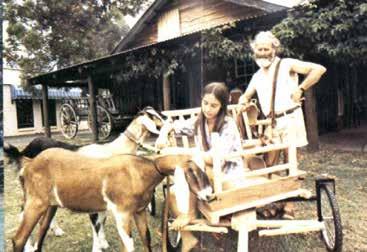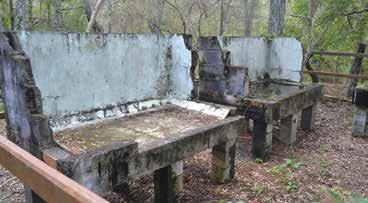
6 minute read
History
WHY COME TO BRIBIE? WHY COME TO BRIBIE?
….early tourist attractions
Advertisement
Barry Clark
Bribie Island Historical Society
MORE BRIBIE HISTORY
The next Historical Society meeting is Wednesday 14 September at 6;30 pm at the RSL Club when our guest speaker will be Al Finegan, who also writes Australian history articles for this magazine. You can see more Bribie history on our new Web Site Bribiehistoricalsociety. org.au and our Blog Site http://bribieislandhistory. blogspot.com or contact us on bribiehistoricalsociety@ gmail.com When the first Jetty was built at Bongaree in 1912 Steamships brought thousands of visitors on day trips and camping holidays. Life was very basic and offered cheap healthy holidays on an island described as "A Zoo without a Fence". Hundreds of white canvas tents were pitched along the Bongaree foreshore and on the Hill where the library stands today, while others stayed in basic holiday huts or Guest houses that were built soon after. The beach at Woorim was the closest Surf beach to Brisbane, even after a three-hour boat trip and a long walk or rough ride on a sand track to the Ocean beach. People made their own entertainment with beach sports and games, dancing and singing, and big fishing competitions with many small boats towed out to location, as shown in the title photo.
NOVELTY GARDENS
An early tourist attraction from1915 were the "Novelty Gardens “around a Guest House with the delightful Welsh name "Glan-Y-Mor" owned by the Davies family who also had a café at the jetty. Their twin daughters, Rose and Lil, met visitors arriving on the steamship “Koopa” and encouraged them to enjoy a fresh fish meal, or carry their bags to the Guest House over long hot sand tracks from the jetty to the corner of Banya and Campbell street. The attraction of "Novelty Gardens” were many trees cleverly cut and trimmed into attractive topiary shapes, with images of a Kangaroo, Steam Engine, Australian Coat of Arms, Steam train and many others in the shady Tea Garden. The Davies family were enterprising, as many pioneer families were, always looking for imaginative ways to serve the visitors and make a living. Their son Bob pushed his home-made food cart around the hundreds of camper’s tents along the foreshore at Bongaree, offering freshly cooked bacon and egg breakfast.
It was a long day on the steamship from Brisbane to Bribie via Redcliffe, walking to Novelty Gardens, lunch, catch a fish and walk or swim before the boat trip home, with drinks and a singalong. No evidence of the Glan-y-Mor Guest House or gardens remains today, other than a few stunted pine trees near the street corner. The comings and goings of Steamships was always a great social event, with crowds coming to wave their welcome or goodbye. With live music and entertainment on board, the bar

of the Steamship Koppa was always a popular watering hole for residents and travellers. It was not until 1939 that the islands first Hotel was built at Woorim, but the threats of World War 2 soon transformed Bribie Island into a defence fortress with limited access for some years. The new modern attraction of Sandstone Point Tavern stands on the site of a large military training camp for Australian and American troops.
BRIDGE BRINGS ATTRACTIONS
After the War the island slowly reopened to residents and visitors, but it was the announcement of a plan to build a bridge to Bribie that initiated several new attractions in the 1960’s. What is now the Baptist Church in Cotterill Avenue was built as Hendon Hall RollerSkating Rink and dance hall in 1962, and later became a Cinema and then Busy Fingers for 20 years, before it became the Baptist Church. The Baptists will soon build a new Church on First Avenue, so who knows what the future holds for that interesting historic building. The "Squatters Craft Homestead” log cabin was located on First Avenue, opposite the sports fields, run by Don Buckley and family, offering Pottery, Gemstones, Leather work and Art & Craft
of all kinds, as well as rides in small carts pulled by goats. A fun-land Waterslide stood for a while on the corner of Goodwin Drive and Kangaroo Avenue, and a Crazy Putt course once operated in First Ave opposite the Jetty. These attractions are long gone, but the remains of one early tourist attraction can still be found in the bush at Red Beach, if you know where to look.
MARINE AQUARIUM
When the Bribie Island Bridge was being built in 1961 and a significant increase in visitor numbers was anticipated, Government incentives were offered to establish new tourist attractions. Long before any Sea World attractions, a new technique was developed by the Aquarium Society of NSW for keeping marine fish in aquariums using a "nature system". An alternative to the traditional approach of filtration, vacuuming and frequent manual cleaning of tanks to remove impurities. The technique was developed in Sydney by Keith and Ruth Inglis using marine snail scavengers and appropriate plants to maintain a balanced tank environment for marine life. Fellow enthusiast Bill Stewart suggested Bribie Island as a suitable location to establish a full-scale nature system marine aquarium, as Moreton Bay offered excellent clean salt water and a wide variety of marine fish, plants, and shellfish With Government and Council support Bill was offered a lease on 2 acres of beachfront
bush at Red Beach on Bribie Island to construct a Marine Aquarium. The Bribie bridge would soon be completed, and with Government incentives, the timing seemed perfect Bill came Bribie Island in 1963, cleared the bush and build 12 large concrete glass-fronted tanks, tropical fish houses, shade covers and pathways. He completed the basic bush setting Aquarium which was opened in August 1964 to a crowd of 300 people plus politicians and Councillors. Bill then spent most of his time diving in the bay to collect fish specimens for display, and it seems that he soon lost interest in this great idea when visitor numbers did not live up to expectation.
Initial thoughts of building his basic on-site accommodation did not eventuate and Bill soon handed it over to Ken Gauld to manage. Sadly, in November 1966 a kerosene fridge caught fire and destroyed many of the structures. Maintenance stopped, the bush quickly encroached on the tanks, fish stocks diminished, and the enterprise was abandoned. Within three years of being opened vandals had damaged many of the Tanks and undergrowth overtook the place. Ruth and Keith Inglis who had pioneered this new technique never got to see the Bribie marine aquarium operational. However, the story does not end there. Ruth & Keith Inglis whose technique was now in use in marine aquariums around the world, retired from their Pet Shop business in Sydney 1990, and came to live on Bribie. After much searching through 24 years of dense overgrown bush, they eventually found the vandalised remains of concrete fish tanks. I had the pleasure of meeting Keith and Ruth in 2007 who told me this story and took me
to see the marine aquarium remains at Red beach, and I also tracked down Bill Stewart who was living on his boat on the Caboolture River. I suggested to the State Government that a suitable sign be erected to explain the interesting but mysterious concrete tank remains to interested residents and visitors. You can now see the remains of this 1960’s attempt at a tourist marine aquarium attraction, and a sign that tells this story, by going to the north end of the car park at Red Beach, and walking a short distance through the bush towards the sea.




